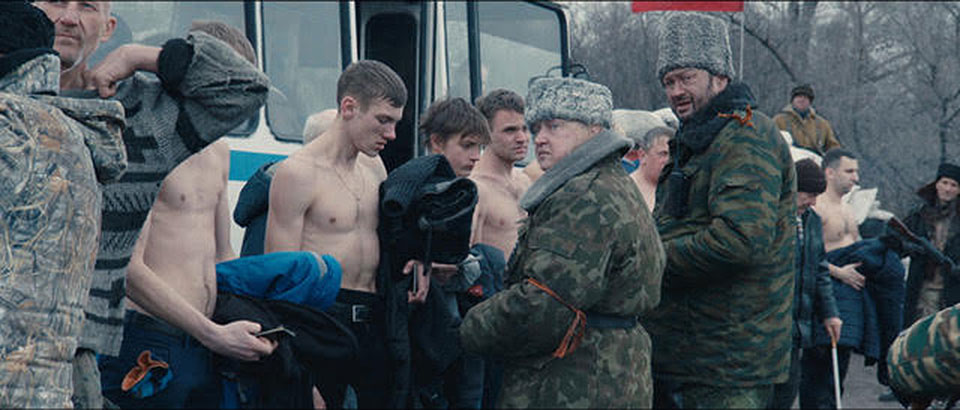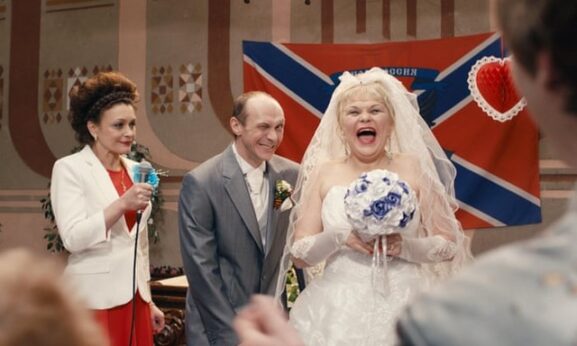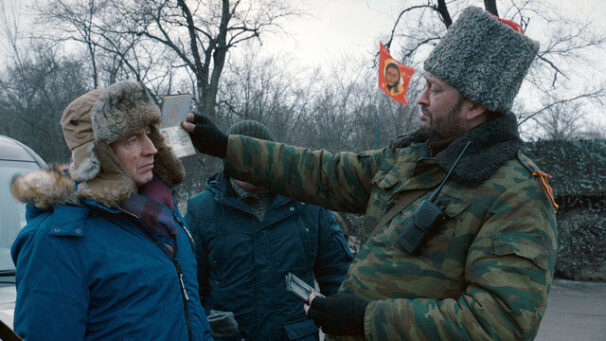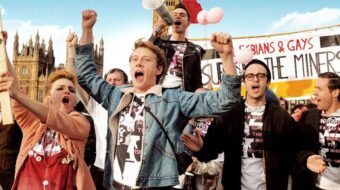
I’ve been a movie fan since childhood and by the time I got to Manhattan’s Hunter College, I’d already seen countless pictures. Majoring in cinema there I devoured copious amounts of cinematic offerings, and then as a professional critic and film historian, I’ve gone on to watch an incalculable number of movies. I mention this because there are scenes in writer/director Sergei Loznitsa’s Donbass—for which he was awarded the Cannes Film Festival’s “Un Certain Regard” accolade—that in all likelihood I’ve never ever seen before on the silver screen.
From what I could discern, there is no major protagonist per se (although there are some recurring characters) whom viewers can follow throughout this labyrinthine film, unlike, say Joska (Petr Kotlar), the boy in that other war-torn Eastern European film, 2019’s The Painted Bird. Loznitsa’s two-hour movie is more like a series of vignettes thematically strung together and stretching over the titular Donbass region in Eastern Ukraine (and methinks Southwestern Russia). This is a hotly contested area where warfare broke out in 2014, roughly between pro-Russian and pro-Ukrainian factions after Moscow seized Crimea. While Americans may feel faraway Ukraine has nothing to do with them, the fact is that this conflict set the stage for Trump’s impeachment imbroglio.
Donbass appears to open with makeup being applied in a trailer to cast members of a movie or television production who are then abruptly rounded up in order to take cover during an attack. In what I believe is the next sequence, government authorities are holding an official session (perhaps it is something like a city council meeting?), and a woman enters and does something rather incredible to whoever seems to be the lead politician. I won’t ruin your surprise by divulging exactly what this infuriated woman does, but let’s just say that it’s a real shit show that’s probably beyond the wildest dreams of Abbie Hoffman and Jerry Rubin perpetrating their “Yippie-est” political theater innovations during the sizzling Sixties.
Although Donbass was shot about two years ago (it is finally being made widely available to Americans) in Ukraine, the perceptive eye may detect some commentary beyond the scope of Eastern Europe. Say what you will about Trump and his administration, it has been an unparalleled spectacle which, like the grotesque freak show at a carnival, you can’t take your eyes off of, the propaganda you must take a gander at. Interestingly, without giving it away, the abovementioned scene in the official chambers actually visually resembles Nov. 19’s bizarre extravaganza—uh, I mean “press conference”—at Republican National Committee headquarters in Washington, wherein Trump’s crazed personal attorney Giuliani (who put the “Rude” into “Rudy”) spewed wild conspiracy theories on behalf of the lunatic loser (allegedly enabling him to charge $20,000 per day) and perspired so much that his hair dye freakishly streaked down his ugly mug, as America is reduced to the level of a banana republic going bananas. Not even Sacha Baron Cohen could conjure up a sideshow so ludicrous in Borat—but somehow Loznitsa does in his acidly observed satire.
 Loznitsa has a documentary as well as a feature film background. On the surface, much of Donbass looks like an Italian Neo-Realist film, but beneath the surface, it is full of Felliniesque vignettes, characters (such as a plump middle-aged blonde at her raucous wedding ceremony), and touches. (Of course, Federico Fellini himself skillfully moved from Neo-Realism to surrealism, as Loznitsa seems to.)
Loznitsa has a documentary as well as a feature film background. On the surface, much of Donbass looks like an Italian Neo-Realist film, but beneath the surface, it is full of Felliniesque vignettes, characters (such as a plump middle-aged blonde at her raucous wedding ceremony), and touches. (Of course, Federico Fellini himself skillfully moved from Neo-Realism to surrealism, as Loznitsa seems to.)
Stylistically, Loznitsa and his cinematographer Oleg Mutu favor lengthy long shots and tracking shots, such as through the labyrinth of a “bomb shelter” where desperate civilians subsist in deplorable conditions. When a chicly-clad young blonde beauty arrives to retrieve her mother and return her to a safe, far more comfortable apartment, her elderly parent refuses to go. What does it mean? Is her mum’s refusal to leave an act of collective solidarity with the other bomb shelter dwellers, most of whom are old enough to have remembered the socialist ethos of sticking together when Ukraine was part of the Soviet Union? Is the attractively clad woman a prostitute? Well, not literally anyway—she’s an apparatchik who works for local politicians.
 Although I am of Ukrainian ancestry, I do not pretend to be an expert in or to understand contemporary Ukrainian politics and conflict. Donbass (which is in Russian—and perhaps some Ukrainian?—with English subtitles) provides tantalizing glimpses and insights into the land of my ancestors. At a checkpoint in the pro-Russian, self-proclaimed “People’s Republic of Donetsk,” a German journalist and his interpreter/photographer are stopped by soldiers who rail against the Nazis. When the reporter pushes back at being identified as a Nazi, an officer declares: “Even if you’re not a fascist your grandfather was.” What are we to make of this so-called “People’s Republic?” Are they leftists trying to revive a form of post-Soviet socialism, separatists, or what?
Although I am of Ukrainian ancestry, I do not pretend to be an expert in or to understand contemporary Ukrainian politics and conflict. Donbass (which is in Russian—and perhaps some Ukrainian?—with English subtitles) provides tantalizing glimpses and insights into the land of my ancestors. At a checkpoint in the pro-Russian, self-proclaimed “People’s Republic of Donetsk,” a German journalist and his interpreter/photographer are stopped by soldiers who rail against the Nazis. When the reporter pushes back at being identified as a Nazi, an officer declares: “Even if you’re not a fascist your grandfather was.” What are we to make of this so-called “People’s Republic?” Are they leftists trying to revive a form of post-Soviet socialism, separatists, or what?
In another scene a man with a placard pinned to him proclaiming he is an “Extermination Guard Volunteer” is tied to a lamppost where, despite his assertions of innocence, he faces merciless mob “justice,” including blows meted out by young toughs trying to impress chicks and taking selfies with the young ladies—and of the hapless prisoner they’re roughing up, if not torturing.
Donbass is full of casual cruelty, incomprehensible carnage (that often comes, literally, from out of the blue), corruption, and more. (No wonder Ukrainians recently elected a comedian to be their president.) In its final sequence Donbass circles back to its opening scene with a horrifying conclusion, rendered largely by a lengthy long shot that bleeds into the title sequence.
Loznitsa’s feature was Ukraine’s official submission for Best Foreign Language Film at the 91st Academy Awards and swept the “Golden Dziga” prizes (named after the immortal Soviet documentarian Dziga Vertov of Kino Pravda fame) for Best Film, Best Director and Best Screenplay at the Ukrainian Film Academy Awards. Press notes and critics observe that Donbass contains commentary on disinformation, propaganda and has an Orwellian outlook regarding our “post-truth” age of “alternative facts.” According to Loznitsa, Donbass’ “absurd, grotesque, comical—even incomprehensible—events are factual and those who experience them find it hard to believe that they are part of their lives.” All I can say is “thank god” my ancestors got the hell out of Odessa and Kiev in 1881 and 1904 and migrated to America—although the way things are going, the USA may end up like embattled Ukraine soon!
Donbass is a political work, but not so much in the straightforward tradition of, say, Costa-Gavras (Z), Gillo Pontecorvo (The Battle of Algiers), or that other Sergei, Sergei Eisenstein (whose classic, Battleship Potemkin, was shot and set in Odessa). With its absurdist, surreal sensibility, Donbass is arguably more redolent of Samuel Beckett (lest we forget, the playwright of Waiting for Godot fought in the French Resistance during World War II) and Luis Buñuel (The Discreet Charm of the Bourgeoisie), who fled Franco.
While Donbass is not intended for those craving mindless entertainment, it’s definitely for serious cineastes who thrive on mindful foreign and indie cinema. In 2018 the IndieWire Critic’s Poll named Donbass one of the “Best Undistributed Films.” The good news is that adventurous North American cinephiles can now watch it (for free for 30 days) on the SVOD platform FILM MOVEMENT PLUS. See here. The trailer can be viewed here.
Fun Fact of the Review: “Dziga Vertov” is Ukrainian for “spinning top.”












Comments